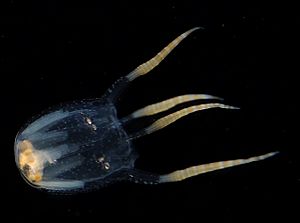Copula sivickisi facts for kids
Quick facts for kids Copula sivickisi |
|
|---|---|
 |
|
| Scientific classification | |
| Genus: |
Copula
|
| Species: |
sivickisi
|
| Synonyms | |
|
|
The Copula sivickisi is a tiny type of box jellyfish. It's the only species in its group, called a monotypic genus. This means it's pretty unique! It's a small, see-through creature with a bell-shaped body and four long tentacles. You'll only see it at night because it hides during the day.
This jellyfish is special because it has a unique way of reproducing. Unlike most jellyfish that release their eggs and sperm into the water, Copula sivickisi has a special mating dance and internal fertilization. Its scientific name honors a Lithuanian scientist named Pranciškus Baltrus Šivickis.
Contents
What Does It Look Like?
The Copula sivickisi is a very small jellyfish. Its main body, called the medusa, grows to only about 10 millimeters (which is about 0.4 inches) across. Its bell is more like a box than the round, umbrella shape of other true jellyfishes.
Inside its clear bell, you can see eight special parts called gonads. In male jellyfish, these look like orange half-circles near the top of the bell. In females, they are white, leaf-shaped parts with speckles.
It has a clear tube hanging from the center of its underside, called a manubrium. Four thin tentacles hang from the edge of the bell, and each one has orange bands. Older female jellyfish also have orange-brown patterns on the edge of their bell.
Where Does It Live?
The Copula sivickisi jellyfish lives in warm, shallow waters. You can find it in many parts of the Pacific Ocean. Its home stretches from Japan and Taiwan down to the Philippines, Vietnam, and Thailand. It also lives near northern Australia, New Zealand, Micronesia, and Hawaii. You can even find it in one spot in the Indian Ocean, off the west coast of Sumatra.
Daily Life and Behavior
This jellyfish is a night owl! It's active only after the sun goes down. During the day, it hides. It has sticky pads on top of its bell that help it attach itself to things.
When the sun comes up, it sinks to the seabed. It spends a few minutes choosing a good hiding spot, often picking the underside of a coral, a stone, or a blade of seagrass. Once it's settled, it folds its tentacles inside its bell and flattens itself. This makes it super hard for people to spot it in its natural home.
As soon as it gets dark, it wakes up and swims higher in the water to start looking for food.
How It Finds Food
The Copula sivickisi has twenty-four eyes! These eyes are grouped on four special stalks called rhopalia, located around the edge of its bell. It's attracted to light and eats tiny sea creatures called zooplankton. This includes glowing organisms.
Its usual way of eating is to swim up to the water surface. Then, it slowly sinks back down with its tentacles spread out, ready to catch any prey that floats by. It often eats tiny crustaceans like copepods and hooded shrimps, as well as young crab larvae and glowing dinoflagellates like Noctiluca. All these tiny creatures are found near the water surface at night.
Reproduction and Life Cycle
Most jellyfish simply release their sperm and eggs into the sea, hoping they meet. But the Copula sivickisi has a much more interesting way to reproduce!
When a male wants to mate, he will grab a female by one of her tentacles and start to pull her around. The two jellyfish then twist around each other, bringing their manubria (the tubes hanging from their bells) close together. The male then passes a red packet of sperm, called a spermatophore, to one of the female's tentacles. She then pushes this sperm packet into her own manubrium.
Female jellyfish have been seen mating with several different males, sometimes up to eight times in just two hours! The eggs inside the female's bell are fertilized by the sperm. About two or three days later, she releases a string of tiny embryos into the sea. These embryos then develop into polyps, which is another stage in the complex life cycle of Cnidaria (the group that includes jellyfish).

